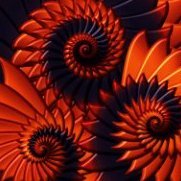-
Posts
1,785 -
Joined
-
Last visited
Profile Information
-
Location
Germany
Recent Profile Visitors
The recent visitors block is disabled and is not being shown to other users.
-
 iconoclast reacted to a post in a topic:
The Art Deco Dream Tool Kit for Affinity Designer
iconoclast reacted to a post in a topic:
The Art Deco Dream Tool Kit for Affinity Designer
-
 iconoclast reacted to a post in a topic:
Automat, 1557 Broadway NY
iconoclast reacted to a post in a topic:
Automat, 1557 Broadway NY
-
 BBG3 reacted to a post in a topic:
Designer: Is there a tool to make rough edges on vectors?
BBG3 reacted to a post in a topic:
Designer: Is there a tool to make rough edges on vectors?
-
As a workaround, you could use Inkscape (free and open source) to roughen the vectors. There are functions called "Add Nodes" and "Jitter Nodes" in the "Extensions" menu under "Modify Path", you can create similar results with. The filter "Fractalize" (in the same menu) could be worth a try too - instead or in addition to "Jitter Nodes".
-
 SimOneTwo reacted to a post in a topic:
Wie kann man Bildbereiche transparent übermalen?
SimOneTwo reacted to a post in a topic:
Wie kann man Bildbereiche transparent übermalen?
-
 Adron reacted to a post in a topic:
When duplicating objects it occasionally shifts a small margin, how to stop this?
Adron reacted to a post in a topic:
When duplicating objects it occasionally shifts a small margin, how to stop this?
-
Eine Methode möchte ich noch nachschieben. Wenn Du ein Bild geöffnet hast, das Du mit einem transparenten Rahmen versehen willst, erstelle eine neue, leere Ebene darüber. Ziehe diese Ebene im Panel "Ebenen" auf das Vorschaubildchen der Ebene darunter (Bildebene), um es darin zu "nesten". Nun kannst Du mit deckender Farbe die Bereiche des Bildes wieder frei malen. Das ist ähnlich wie bei einer Ebenenmaske. Eine sehr handliche und intuitive Methode. Um an der Maske zu malen, muss sie aber auch immer angeklickt sein. Noch ein Hinweis. Damit der Rand im Resultat wirklich transparent und nicht einfach nur weiß ist, musst Du im Menü "Document" immer "Transparenter Hintergrund" auswählen. Jedenfalls in Photo. In Designer musst Du das in den "Dokumenteneinstellungen" (Menü "Datei") unter "Farbe" auswählen.
-
 nickbatz reacted to a post in a topic:
Paintbrush in Photo tool not painting
nickbatz reacted to a post in a topic:
Paintbrush in Photo tool not painting
-
In my experience, it is a classic problem that small hidden selections cause such problems, because you can only paint on areas that are inside this selection, even you can't see the selection. I remember very well how often such tiny hidden selections drove me mad in my early Photoshop-Days. I'm not sure if it is the problem in this case, but as it seems, it is only a problem with one certain document. So I think that a restart of the computer will probably not solve the problem. At least it would be easy and worth it to check out if there is a hidden selection.
-
 Old Bruce reacted to a post in a topic:
Paintbrush in Photo tool not painting
Old Bruce reacted to a post in a topic:
Paintbrush in Photo tool not painting
-
 Alfred reacted to a post in a topic:
Paintbrush in Photo tool not painting
Alfred reacted to a post in a topic:
Paintbrush in Photo tool not painting
-
 PaulEC reacted to a post in a topic:
Draw a Grid in Designer
PaulEC reacted to a post in a topic:
Draw a Grid in Designer
-
Simply draw a vertical line. Then hit "Enter" to start the dialogue "Move/Duplicate". Enter the values you need ("Horizontal" and "Number of Duplicates") and click "OK". Then repeat the same with a horizontal line and "Vertical" duplicates. If you set the cursor into the "Number of Duplicates"-field, you can also increase/decrease the number of duplicates with the Arrow Buttons on the keyboard. I Think, this is the easiest way.
-
 iconoclast reacted to a post in a topic:
Pin Pals – Affinity Designer Enamel Pin Creator
iconoclast reacted to a post in a topic:
Pin Pals – Affinity Designer Enamel Pin Creator
-
 TheFlow reacted to a post in a topic:
Is Stroke Path available yet?
TheFlow reacted to a post in a topic:
Is Stroke Path available yet?
-
 XZY reacted to a post in a topic:
Depth map support
XZY reacted to a post in a topic:
Depth map support
-
 XZY reacted to a post in a topic:
Remove all pixels darker than ____
XZY reacted to a post in a topic:
Remove all pixels darker than ____
-

Vector Pinsel
iconoclast replied to Ronald H.'s topic in Pre-V2 Archive of Affinity on Desktop Questions (macOS and Windows)
Hi Ricardo! Ja, Vektor-Pinsel funktionieren nur in Designer und der Designer Persona, Rasterpinsel nur in AfPhoto und der Photo Persona. Wenn du also alle drei Programme hast (Publisher, Photo und Designer) werden installierte Pinsel auch in den jeweiligen Personas installiert. Sollte aber wohl auch so funktionieren wenn man nur die zwei Apps hat, glaube ich. In den Personas findets du die Pinsel dann in den Pinselpanelen. Die meisten Vektor-Pinsel sind übrigens nicht wirklich Vektor-Pinsel. Es sind Rastergrafiken, die nur an Vektoren ausgerichtet werden. Die Pinselstriche sind also nicht verlustfrei skalierbar. -
 iconoclast reacted to a post in a topic:
9 vector dot frames
iconoclast reacted to a post in a topic:
9 vector dot frames
-
 iconoclast reacted to a post in a topic:
Musical Brushes
iconoclast reacted to a post in a topic:
Musical Brushes
-
There is an option called "Import Palette" in the burger menu of the "Swatches" panel.
-
You could also try the free G'MIC plugin. There is a filter called Grid (Cartesian) in the category Arrays & Tiles, that does almost what you are looking for. This filter segments the text on the text level into squares. Between the squares, it creates transparent gaps, so that the black background is visible there. The edges of the text will be a bit greyish, but you only need to fiddle a little bit with increasing contrast and brightness to finally get a clean result. If you don't know the G'Mic plugin, as I said, it is free (open source) and very recommendable. It contains more than 600 additional filters. And many of them are very good.
-
This is not unusual. As far as I remember, the same happens with the most applications if you install a new one. The most people e.g. only have one image editing app installed, and they will want to open their image files with it. So these apps change the "Open with" setting of your OS. Its a kind of service. But the files themselves will not be changed. It is only that your OS will open them with that certain app. And as MikeTO already said,you can easily change that the way you want.


